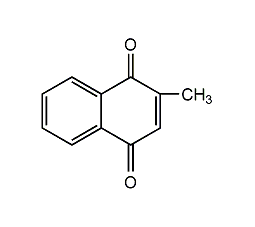2-Methyl-1,4-naphthoquinone 2-Methyl-1,4-naphthoquinone


Structural formula
| Business number | 019C |
|---|---|
| Molecular formula | C11H8O2 |
| Molecular weight | 172.18 |
| label |
menaquinone, Vitamin K, Menadione, Vitamin K3, Menaphthone, 2-Methyl-1,4-naphthoquinone |
Numbering system
CAS number:58-27-5
MDL number:MFCD00001681
EINECS number:200-372-6
RTECS number:QL9100000
BRN number:1908453
PubChem number:24897023
Physical property data
1. Properties: White crystal or crystalline powder, almost odorless, hygroscopic, and changes color when exposed to light. Has a slightly spicy smell. Stable in air, decomposes in sunlight.
2. Density (g/mL, 25/4℃): 1.225
3. Relative vapor density (g/mL, air=1): Undetermined
4. Melting point (ºC): 102-1065. Boiling point (ºC, normal pressure): 102~106
6. Boiling point (ºC, 5.2kPa): Undetermined
7. Refractive index: Unknown Determined
8. Flash point (ºC): Undetermined
9. Specific rotation (º): Undetermined
10. Autoignition point or ignition Temperature (ºC): Undetermined
11. Vapor pressure (kPa, 25ºC): Undetermined
12. Saturated vapor pressure (kPa, 60ºC): Undetermined
13. Heat of combustion (KJ/mol): Undetermined
14. Critical temperature (ºC): Undetermined
15. Critical pressure (KPa): Undetermined
16. The logarithmic value of the oil-water (octanol/water) partition coefficient: Undetermined
17. The upper limit of explosion (%, V/V): Undetermined
18. Lower explosion limit (%, V/V): Undetermined
19. Solubility: 1g product is soluble in about 60ml ethanol, 10ml benzene, 50ml vegetable oil, and soluble in chloroform and carbon tetrachloride. soluble in water. Ethanol solutions are neutral to litmus paper. The solution does not decompose when heated to 120°C. It will be destroyed when encountering alkali and reducing agent. Insoluble in ether and benzene.
Toxicological data
None
Ecological data
None
Molecular structure data
5. Molecular property data:
1. Molar refractive index: 47.60
2. Molar volume (cm3/mol): 140.5
3. Isotonic specific volume (90.2K): 366.8
4. Surface tension (dyne/cm): 46.4
5. Polarizability (10-24cm3): 18.87
Compute chemical data
1. Reference value for hydrophobic parameter calculation (XlogP): None
2. Number of hydrogen bond donors: 0
3. Number of hydrogen bond acceptors: 2
4. Number of rotatable chemical bonds: 0
5. Number of tautomers: 3
6. Topological molecule polar surface area 34.1
7. Number of heavy atoms: 13
8. Surface charge: 0
9. Complexity: 289
10. Number of isotope atoms: 0
11. Determine the number of atomic stereocenters: 0
12. Uncertain number of atomic stereocenters: 0
13. Determine the number of chemical bond stereocenters: 0
14. Number of uncertain chemical bond stereocenters: 0
15. Number of covalent bond units: 1
Properties and stability
1. Exist in smoke.
Storage method
This product should be sealed and stored in a cool, dry place away from light.
Synthesis method
1. Methylnaphthalene is obtained by oxidation of chromic anhydride. Dissolve 2-methylnaphthalene in glacial acetic acid, stir and cool to below 40°C, slowly add a mixture of chromic anhydride and an equal amount of water to maintain the temperature at 35-40°C. After the addition, keep the reaction mixture at 40°C for 0.5h, raise the temperature to 70°C and keep it for 45min, then raise the temperature to 85°C and keep it for 15min. Pour the reactant into a large amount of water, and precipitate 2-menaquinone under constant stirring. Filter, wash the filter cake with water repeatedly until the aqueous solution has no sour taste, and filter to dryness to obtain 2-menaquinone. The yield is 51%. Sodium dichromate can also be used for 2-methylnaphthalene; the oxidation yield of potassium dichromate is roughly the same.
2. 2-methylnaphthohydroquinone is obtained by cyclization of toluoquinone and butadiene, and then oxidized with chromic acid. Add toluoquinone to glacial acetic acid to dissolve, and pass in butadiene until the required amount is reached below 20°C. After being sealed and left to stand for 20 hours, heat to release the remaining butadiene, continue to heat to about 110°C and reflux for 3 hours, and then distill under reduced pressure to recover about 30% of glacial acetic acid. Then cool to below 40°C, slowly add a mixture of chromic acid and an equal amount of water to keep the temperature at 65-70°C, complete the addition, and keep it at 70-80°C for 1 hour to generate menadione.
Purpose
For biochemical research.
Vitamin K3 can be obtained by adding this product to sodium bisulfite.
